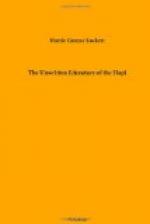[Illustration: Figure 11.—Snake Priests with Snake.
—Photo by Bortell]
Very quietly and without rising, a man in the third row picked up the snake and handed it to the gatherer. The writer shuddered but did not realize that the impromptu gatherer was her son, so bronzed by a summer’s archaeology field trip that she did not recognize him. Afterward he merely said, “It was a harmless bull snake, and the priest couldn’t reach it; it’s a shame for visitors to crowd up and get in the way unless they are prepared to sit perfectly still, whatever happens.” Really one feels ashamed of the squealing and frightened laughter of careless white visitors who stand or sit nearer than they should and then make an unseemly disturbance when a snake gets too close. The priests resent such conduct, but always go right on without paying any attention to it. The rattles and singing voices of the Antelope priests furnish a dignified, rhythmic accompaniment throughout the dance, and the Snake men move in perfect time to it.
When all the snakes have been carried and the last one has been dropped from the mouth of the carrier, the chant ceases. A priest draws a great round cloud symbol on the ground. Quickly the Hopi maids and women, (a small selected group), who stand ready with baskets of meal, sprinkle the ground within the circle. At a signal all the snakes, now in the hands of the gatherers and the Antelope priests, are thrown upon this emblem. The women hastily drop sacred meal on the mass of snakes, then a second signal and the Snake priests grab up the whole writhing mass in their hands and run in the four directions off the steep mesa, to deposit their Elder Brothers again in the lowlands with the symbolic sacred meal on their backs, that they may bear away to the underground the prayers of their Younger Brothers, the Snake Clan. The Antelope priests now circle the plaza four times, stamping on the sipapu in passing, and then return to their own kiva, and the dance is over. The Snake priests presently return to the village, still running, disrobe in their kiva and promptly go to the nearest edge of the mesa, where the women of their clan wait with huge bowls of emetic (promptly effective) and tubs of water for bathing. This is the purification ceremony which ends the ritual. Immediately the women of their families bring great bowls and trays of food and place them on top of the Snake Kiva, and the men, who have fasted all day and sometimes longer, enjoy a feast.




